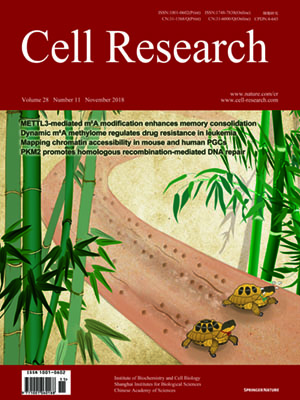
Volume 28, No 11, Nov 2018
ISSN: 1001-0602
EISSN: 1748-7838 2018
impact factor 17.848*
(Clarivate Analytics, 2019)
Volume 28 Issue 11, November 2018: 1103-1117
ORIGINAL ARTICLES
Elimination of CD4lowHLA-G+ T cells overcomes castration-resistance in prostate cancer therapy
Chao Wang 1,2 , Jiahuan Chen 3 , Qianfei Zhang 1,2 , Wang Li 1 , Shengbo Zhang 1,2 , Yanjie Xu 1,2 , Fang Wang 1 , Bing Zhang 3 , Yan Zhang 1,2 and Wei-Qiang Gao 1,2
1 State Key Laboratory of Oncogenes and Related Genes, Renji-MedX stem Cell Research Center, Ren Ji Hospital, School of Biomedical Engineering, Shanghai Jiao Tong University,Shanghai 200030, China; 2Med-X Research Institute & School of Biomedical Engineering, Shanghai Jiao Tong University, Shanghai 200030, China and 3Key Laboratory of Systems Biomedicine, Shanghai Center for Systems Biomedicine, Shanghai Jiao Tong University, Shanghai 200240, China
Correspondence: Correspondence: Yan Zhang (yanzh@sjtu.edu.cn) or Wei-Qiang Gao (gao.weiqiang@sjtu.edu.cn)
Androgen deprivation therapy (ADT) is a main treatment for prostate cancer (PCa) but the disease often recurs and becomes castration-resistant in nearly all patients. Recent data implicate the involvement of immune cells in the development of this castration-resistant prostate cancer (CRPC). In particular, T cells have been found to be expanded in both PCa patients and mouse models shortly after androgen deprivation. However, whether or which of the T cell subtypes play an important role during the development of CRPC is unknown. Here we identified a novel population of CD4lowHLA-G+ T cells that undergo significant expansion in PCa patients after ADT. In mouse PCa models, a similar CD4low T cell population expands during the early stages of CRPC onset. These cells are identified as IL-4-expressing TH17 cells, and are shown to be associated with CRPC onset in patients and essential for the development of CRPC in mouse models. Mechanistically, CD4lowHLA-G+ T cells drive androgen-independent growth of prostate cancer cells by modulating the activity and migration of CD11blowF4/80hi macrophages. Furthermore, following androgen deprivation, elevated PGE2-EP2 signaling inhibited the expression of CD4 in thymocytes, and subsequently induced the polarization of CD4low naïve T cells towards the IL-4-expressing TH17 phenotype via up-regulation of IL23R. Therapeutically, inactivating PGE2 signaling with celecoxib at a time when CD4lowHLA-G+ T cells appeared, but not immediately following androgen deprivation, dramatically suppressed the onset of CRPC. Collectively, our results indicate that an unusual population of CD4lowHLA-G+ T cells is essential for the development of CRPC and point to a new therapeutic avenue of combining ADT with PGE2 inhibition for the treatment of prostate cancer.
https://doi.org/10.1038/s41422-018-0089-4
FULL TEXT | PDF
Browse 1237


